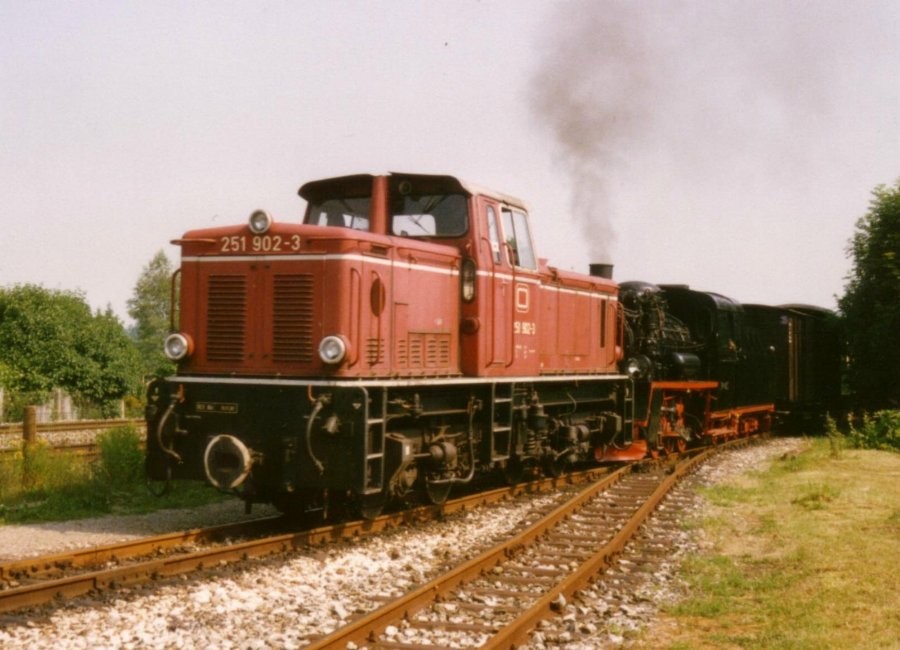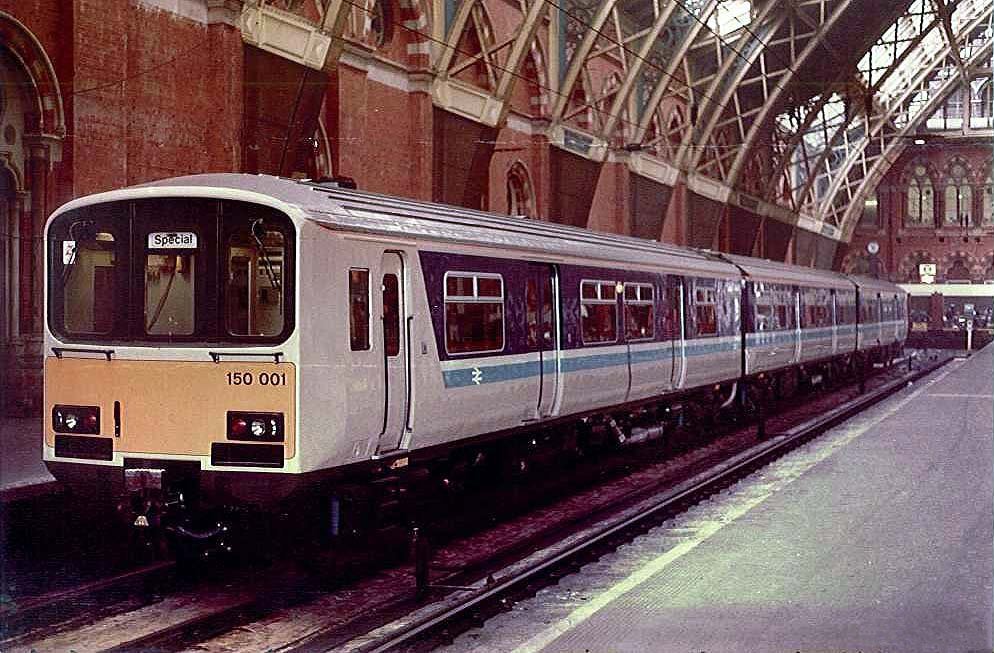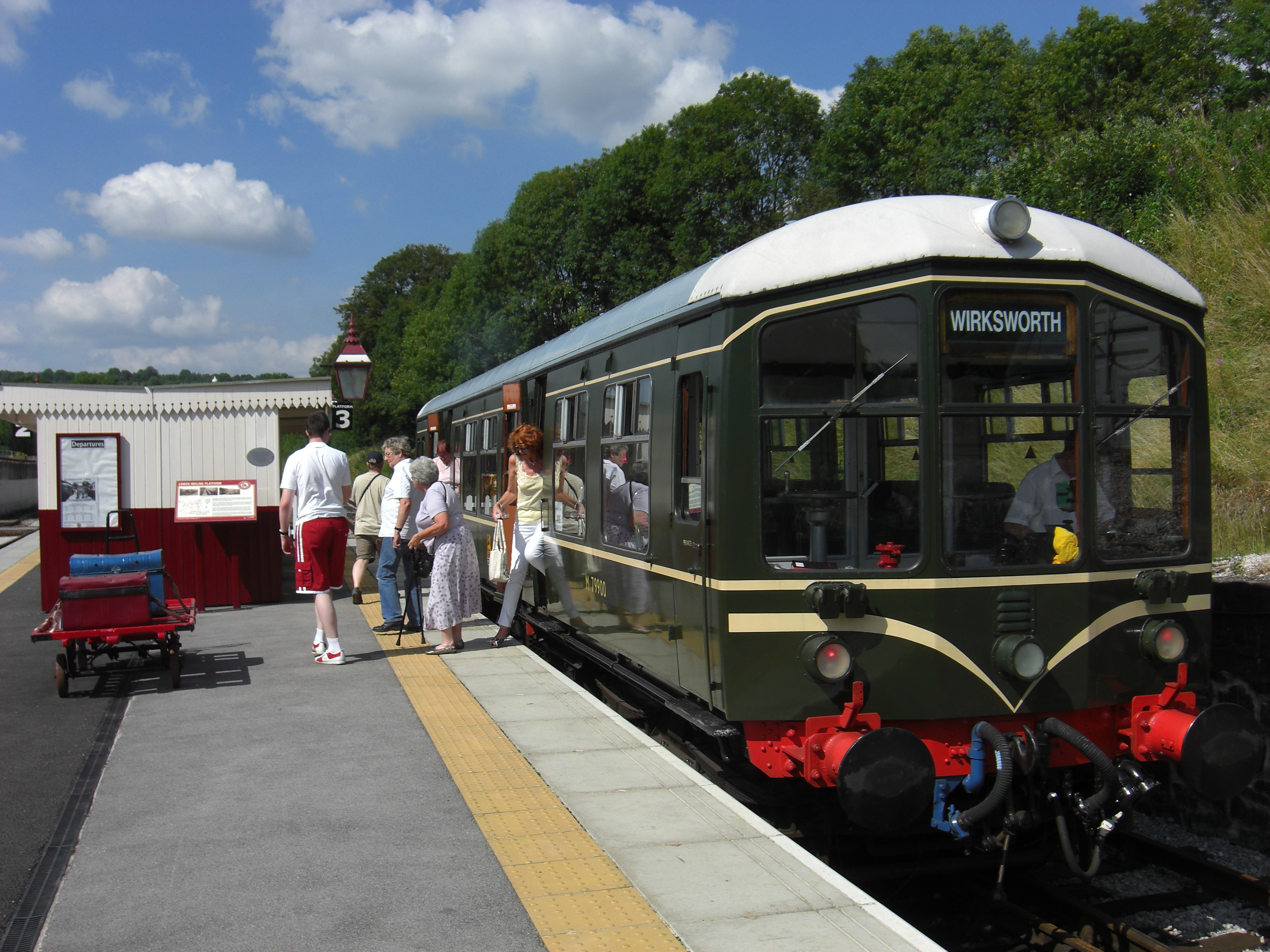|
British Rail Class 140
The British Rail Class 140 was the prototype of the ''Pacer'' diesel multiple unit. It was constructed between 1979 and 1981 in response to a desire within British Rail to develop a capable railbus for its smaller branch line services. Much of the bodywork was constructed using Leyland National bus components, with the exception of the cabs. Based on the single car railbus prototypes, the Class 140 was built to BR's then stringent regulations regarding crashworthiness and resistance to end loading; as such, much of its intention lightweight 'bus on a wagon' look was lost, becoming a more substantial vehicle. Throughout the 1980s, the sole member of the class functioned as a trials and demonstration unit, acting as a herald to the closely related Class 141. Since its withdrawal, the unit has been preserved at the Keith and Dufftown Railway. Background By the beginning of the 1980s, British Rail (BR) operated a large fleet of first generation DMUs, which had been construct ... [...More Info...] [...Related Items...] OR: [Wikipedia] [Google] [Baidu] |
Landore TMD
Landore TMD is a railway traction maintenance depot situated in Landore, a district of Swansea, Wales. There was a shed for steam locomotives here, and in 1963 British Rail opened a purpose-build diesel depot. Under privatisation the depot was operated by Great Western Railway to service its fleet of InterCity 125s until it closed in December 2018. The site reopened in September 2019 as a rolling stock refurbishment centre. History The Great Western Railway built a shed a Landore in 1932. Under British Rail, Landore shed was given the shed code 87E and from 1949 all locomotives allocated there bore a small plate showing this code. In 1950 there were 60 locomotives allocated to Swansea of which 34 were tank locomotives. By 1959 the total number had risen to 68 but only 33 of these were shunters. The steam shed was closed in June 1961, and in 1963 a new purpose-build diesel depot was opened. Under the BR TOPS system introduced in 1973 this new depot was given the depot code LE. ... [...More Info...] [...Related Items...] OR: [Wikipedia] [Google] [Baidu] |
Tightlock Coupling
Type H Tightlock couplers are a variety of Janney coupler, typically used on North American mainline passenger rail cars. They have mechanical features that reduce slack in normal operation and prevent telescoping in derailments, yet remain compatible with other Janney types used by North American freight railroads. Like all Janney couplers, the Tightlock is "semi-automatic". The couplers automatically lock when cars are pushed together, but workers must go between cars to hook up the air lines for the pneumatic brakes and connect cables for head-end power and other communications. To separate cars, a worker must use a lever to move the locking pin that keeps the coupler closed. In Europe, some operators experimented with making fully automatic tightlock couplers by adding integral pneumatic and electric connectors, but these connections proved unreliable, and most have switched to the more common fully automatic Scharfenberg coupler. Janney Type H Tightlock coupler stand ... [...More Info...] [...Related Items...] OR: [Wikipedia] [Google] [Baidu] |
Gmeinder
Gmeinder GmbH was a German locomotive and engineering company based in Mosbach. Its products included diesel engines, small locomotives (shunters) and other railway locomotive parts. Much of its business came through the German railways, though it also exported to the rest of Europe and the rest of the world. From 2004 onwards the company was split into two separate concerns - Gmeinder Lokomotivenfabrik which manufactures locomotives and Gmeinder Getriebe- und Maschinenfabrik which makes components - specifically railway axle gearboxes. History Source: In 1913 The company Steinmetz Gmeinder KG was founded in Mosbach by Anton Gmeinder and August Steinmetz, six years later the company name was changed to "A. Gmeinder & Cie.". The same year a locomotive with a petrol engine was made. In 1925 another change of identity occurred - with the organisation becoming Gmeinder & Co. GmbH with Anton Gmeinder and Carl and Hermann Kaelble as co-partners. In 1964 with financial support from t ... [...More Info...] [...Related Items...] OR: [Wikipedia] [Google] [Baidu] |
Brake Block
A railway brake is a type of brake used on the cars of railway trains to enable deceleration, control acceleration (downhill) or to keep them immobile when parked. While the basic principle is similar to that on road vehicle usage, operational features are more complex because of the need to control multiple linked carriages and to be effective on vehicles left without a prime mover. Clasp brakes are one type of brakes historically used on trains. Early developments In the earliest days of railways, braking technology was primitive. The first trains had brakes operative on the locomotive tender and on vehicles in the train, where "porters" or, in the United States brakemen, travelling for the purpose on those vehicles operated the brakes. Some railways fitted a special deep-noted brake whistle to locomotives to indicate to the porters the necessity to apply the brakes. All the brakes at this stage of development were applied by operation of a screw and linkage to brake blo ... [...More Info...] [...Related Items...] OR: [Wikipedia] [Google] [Baidu] |
Union Internationale Des Chemins De Fer
The International Union of Railways (, UIC) is an international rail transport industry body based in Paris. History The railways of Europe had originated during the nineteenth century as many separate concerns across numerous nations; this led to disparate and conflicting standards emerging and thus onto incompatibility. One prominent example was the British Gauge War, during which different rail transport, railway companies were laying different track gauges across Great Britain, causing inefficiency wherever a break of gauge occurred, prior to an Regulating the Gauge of Railways Act 1846, Act of Parliament the issue in 1846 by establishing one standard gauge of . The early effort towards standardisation somewhat influenced railways aboard as well, however various other track gauges persisted and developed across the world; even through to the twenty first century, incompatible track gauges, let alone other issues, persisted to hinder interoperability efforts. Several key eve ... [...More Info...] [...Related Items...] OR: [Wikipedia] [Google] [Baidu] |
British Rail Sprinter
The Sprinter is a family of diesel multiple unit trains in use on the Rail transport in Great Britain, British railway system. They were built in the 1980s and early-1990s by British Rail Engineering Limited (BREL), Metro-Cammell and British Leyland, Leyland. Sprinters operate in almost every part of Great Britain, from rural branch lines to commuter expresses into major cities. The class includes British Rail Class 150, class 150, British Rail Class 151, 151, British Rail Class 153, 153, 154, British Rail Class 155, 155, British Rail Class 156, 156, British Rail Class 158, 158 and British Rail Class 159, 159. Most have Cummins UK, Cummins engines with Voith hydraulic transmissions, although 47 Class 158 units have Perkins Engines, Perkins engines instead. Originally British Rail coined the "Sprinter" name for the units, mainly to promote the superior acceleration capabilities of the units compared with the first-generation DMUs they replaced. Advertisements such as "The Spri ... [...More Info...] [...Related Items...] OR: [Wikipedia] [Google] [Baidu] |
British Rail Class 151
The British Rail Class 151 was a prototype class of diesel multiple unit (DMU) developed and constructed by the British railway equipment manufacturer Metro Cammell. It was designed primarily to serve as a successor to the earlier first-generation "Heritage" DMUs operated by the British Rail (BR). Development of the Class 151 commenced during 1983 in response to a specification issued by BR calling for a new generation of DMU with which to equip its fleet. Both Metro Cammell and British Rail Engineering Limited (BREL) were selected to produce prototypes of their design submissions. Accordingly, a pair of 3-car units were constructed, which entered trial service with BR during 1985. If it had emerged successful, the Class 151 would have likely become the basis of ''Sprinter'' family of DMUs that were produced during the 1980s. However, following a competitive evaluation against the rival Class 150, the type did not secure a production contract, having lost out to its BREL-bui ... [...More Info...] [...Related Items...] OR: [Wikipedia] [Google] [Baidu] |
Asbestos
Asbestos ( ) is a group of naturally occurring, Toxicity, toxic, carcinogenic and fibrous silicate minerals. There are six types, all of which are composed of long and thin fibrous Crystal habit, crystals, each fibre (particulate with length substantially greater than width) being composed of many microscopic "fibrils" that can be released into the atmosphere by Abrasion (mechanical), abrasion and other processes. Inhalation of asbestos fibres can lead to various dangerous lung conditions, including mesothelioma, asbestosis, and lung cancer. As a result of these health effects, asbestos is considered a serious Health hazard, health and safety hazard. Archaeological studies have found evidence of asbestos being used as far back as the Stone Age to strengthen ceramic pots, but large-scale mining began at the end of the 19th century when manufacturers and builders began using asbestos for its desirable physical properties. Asbestos is an excellent Thermal insulation, thermal and In ... [...More Info...] [...Related Items...] OR: [Wikipedia] [Google] [Baidu] |
List Of British Rail Diesel Multiple Unit Classes
This is a list of British Rail diesel multiple-unit train classes. For a historical overview of diesel multiple unit train development in Great Britain, see British railcars and diesel multiple units. Pre-nationalisation designs * GWR railcars * LMS railcars First generation Early BR DMUs (79xxx series) TOPS classes Second generation Lightweight railcars Pacers Sprinters Turbos Networker Turbostar Coradias Desiro Civity Diesel-electric multiple units (DEMUs) Southern Region DEMUs Second Generation Voyager-style express DEMUs High-speed trains See also * List of British Rail classes * List of British Rail modern traction locomotive classes * List of British Rail electric multiple unit classes * British Rail locomotive and multiple unit numbering and classification * British Rail coach type codes References External links * {{British Rail DMU British Rail diesel multiple units, List British railway-related lists, British Rail diesel multipl ... [...More Info...] [...Related Items...] OR: [Wikipedia] [Google] [Baidu] |
Keith And Dufftown Railway
The Keith and Dufftown Railway ("The Whisky Line") is a heritage railway in Scotland, running for from , Keith (Ordnance Survey grid reference ) to () via () and Auchindachy. Originally the former Great North of Scotland Railway's Keith and Dufftown Railway, which was part of the link Aberdeen with Elgin (with the Strathspey Railway and Morayshire Railway), the line was latterly a freight-only branch for British Rail then truncated at Dufftown and serving the distillery there. Regular passenger services had been withdrawn in May 1968, but in later years it hosted a series of ''Northern Belle'' summer Sunday lunch specials from Aberdeen. These ceased in 1991 and after several years disuse, the line passed into the hands of the current operator in 1998; regular heritage trains then began running in 2000. The line is open, and a regular service runs throughout the railway's operating season from March to September. Special events are also run, including Santa Specials ... [...More Info...] [...Related Items...] OR: [Wikipedia] [Google] [Baidu] |
British Rail Class 141
The British Rail Class 141 is the first production model of the Pacer (British Rail), ''Pacer'' diesel multiple unit (DMU) railbus. During the 1980s, British Rail (BR) was interested in replacing its first generation diesel multiple units, particularly in the use of railbuses to service its lightly used branch lines. It was decided to develop such a vehicle with a high level of commonality with the widely used Leyland National bus, leading to its modular design serving as the basis for the design. Several single and two-car prototypes were constructed and evaluated, before an order was placed with British Leyland for 20 two-car Class 141 units during 1984. During their operating lives, the units were tasked with various passenger services across the UK for 13 years. Following withdrawal, a large proportion of the units were exported to Iran where they operated for a further eight years, giving the Class 141 a total lifespan of 21 years. Background By the beginning of the 1980s, ... [...More Info...] [...Related Items...] OR: [Wikipedia] [Google] [Baidu] |
Crashworthiness
Crashworthiness is the ability of a structure to protect its occupants during an impact. This is commonly tested when investigating the safety of aircraft and vehicles. Different criteria are used to figure out how safe a structure is in a crash, depending on the type of impact and the vehicle involved. Crashworthiness may be assessed either prospectively, using computer models (e.g., RADIOSS, LS-DYNA, PAM-CRASH, MSC Dytran, MADYMO) or experiments, or retrospectively, by analyzing crash outcomes. Several criteria are used to assess crashworthiness prospectively, including the deformation patterns of the vehicle structure, the acceleration experienced by the vehicle during an impact, and the probability of injury predicted by human body models. Injury probability is defined using criteria, which are mechanical parameters (e.g., force, acceleration, or deformation) that correlate with injury risk. A common injury criterion is the head impact criterion (HIC). Crashworthiness is ... [...More Info...] [...Related Items...] OR: [Wikipedia] [Google] [Baidu] |







